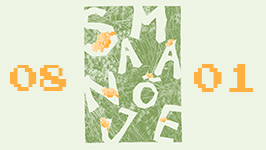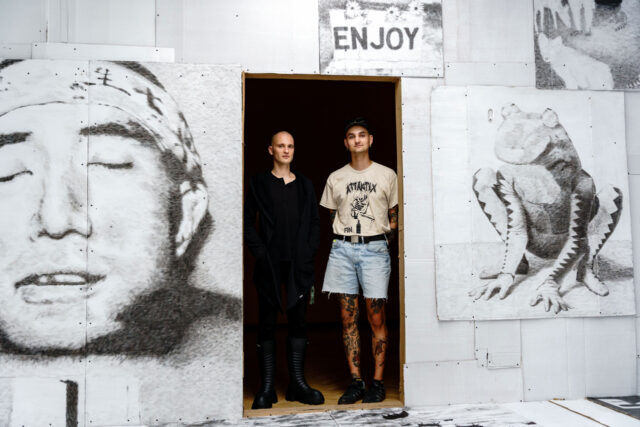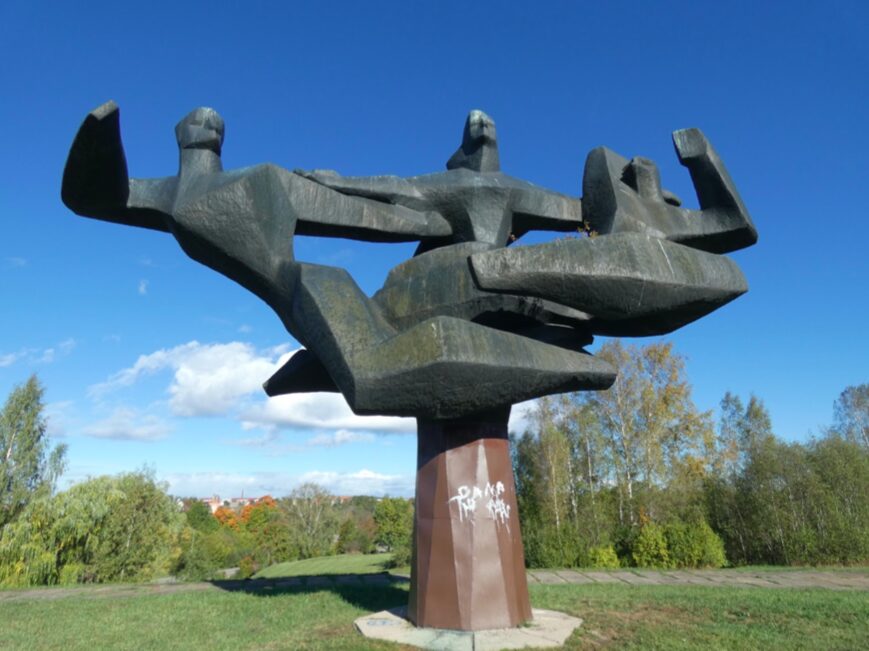Margot Samel is pleased to present Breaking up of ice on a river, a group exhibition featuring artists Carolina Fusilier, Nina Hartmann, Jaanus Samma, Tai Shani, Anastasia Sosunova, and Johanna Ulfsak, curated by Lilian Hiob, opening on May 17, 2024.
In the confines of this exhibition space, we are greeted by a surreal spectacle—floating jockstraps, each adorned with an intricate set of Estonian national embroidery, appearing to defy gravity, their tethers bound to the gallery floor by a chain and a weighty concrete block. This initial encounter sets the tone for an exploration of the enigmatic, the unexpected, and the subversive. Nearby, a series of collages rests on the gallery walls. Combining offset lithography, intaglio, and woodcut techniques with digital prints and found materials, the imagery is a patchwork of found motifs sourced from the boundless expanse of cyberspace and from personal photo archives. These collages, interwoven with intimate scenes of tenderness plucked from the pages of LGBTQ+ magazines, offer a testament to the raw and unapologetic celebration of queer existence.
In the corner of one of these collages we see a little basket. Ursula K. Le Guin, a luminary of science fiction provocatively challenges our preconceived notions of the early tools used by humans by suggesting that the genesis of human tools did not lie in the phallic and violent usurpation of another species but rather in a far more humble object—a basket or a cloth bag. These unassuming vessels, carriers of sustenance, weave a thread of unity and nourishment throughout the tapestry of human history. However, beneath the surface of this modest tool, a darker undercurrent flows. Ergot, a sinister fungus that thrives in wet rye, occasionally infiltrates the grain, leading to hallucinations and even gangrene in those who ingest it. The peasants, consuming inferior quality grain compared to their landlords, found themselves disproportionately affected by this hallucinogenic menace. Nestled in the right armpit of Europe’s easternmost country, Estonia, lies the island of Kihnu. Here, the matriarchal way of life reigns supreme. The eldest woman of each family takes centre stage—she embodies the knowledge and heritage of Kihnu culture, where old age equates to power and authority. Intriguingly, Kihnu women are traditionally involved in matchmaking with mothers deciding on the partners of their children. At funerals, it is not unusual for women to bear the solemn duty of carrying the coffin, signifying their place of importance in their society. Notably, Kihnu women’s traditional attire incorporates a knife—a once-phallic symbol now confidently wielded by women in this unique tradition. As an island, Kihnu is surrounded by the sea and the pike is among the more popular sea creatures consumed for food. With its elongated and relatively unbending body and greenish-blue bones, it provokes mixed reactions. To some, the color blue signifies toxins and spoiled food, a warning etched into our collective ancestral memory.
This dualism of the colour blue extends to the realm of authority, as police uniforms bear this hue as well. It serves as both a cautionary sign of potential toxicity and an emblem of safety and order. These associations are deeply ingrained, shaping our perceptions from childhood. Disney’s wildly popular animated series, Paw Patrol offers a curious lens through which we can scrutinize the perpetuation of normative beliefs regarding law enforcement and the overarching control society. In its whimsical portrayal, it unabashedly champions a heroic vision of the police and authorities, albeit in the form of furry four-legged anthropomorphic animals.
Yet, our exploration takes a surreal and disorienting turn, we descend into a surreal dreamscape, where the boundaries between reality and illusion blur. The machinations of a control society, depicted already decades ago in Terry Gilliam in Brazil and today exacerbated by algorithms and pervasive data collection, loom closer than ever. The invisible web of control, machine vision, and social alienation imbues every facet of our existence, entwining us in its intricate embrace. Amidst the labyrinthine web of software and hardware boundaries blur and it becomes an onerous task to discern whether what unfolds before our eyes is an unvarnished reflection of reality, a stark illumination of the clandestine systems that envelop us, or a fantastical, unbridled, and profoundly personal projection of our very imagination.
What unravels within this exhibition is not a mere mirage, fantasy of a better or a dystopian society. It’s a vivid tapestry, woven from the complex threads of reality, perception, and the intricacies of our shared human experience. It opens up as a profound reflection of the oft-neglected traditions and clandestine undercurrents of subversive social patterns that have long lurked in the penumbras of the prevailing narrative. They lie in wait, ready to challenge the established order and to illuminate the enigmatic recesses of our shared human experience, unearthing the stories and perspectives that have long been obscured.
– Curator, Lilian Hiob
Breaking up of ice on a river
Curated by Lilian Hiob
Participating artists Carolina Fusilier, Nina Hartmann, Jaanus Samma, Tai Shani, Anastasia Sosunova, and Johanna Ulfsak
Margot Samel
295 Church Street
New York, NY 10013
May 18, 2024 – June 22, 2024
Preview: May 17, 2024





























